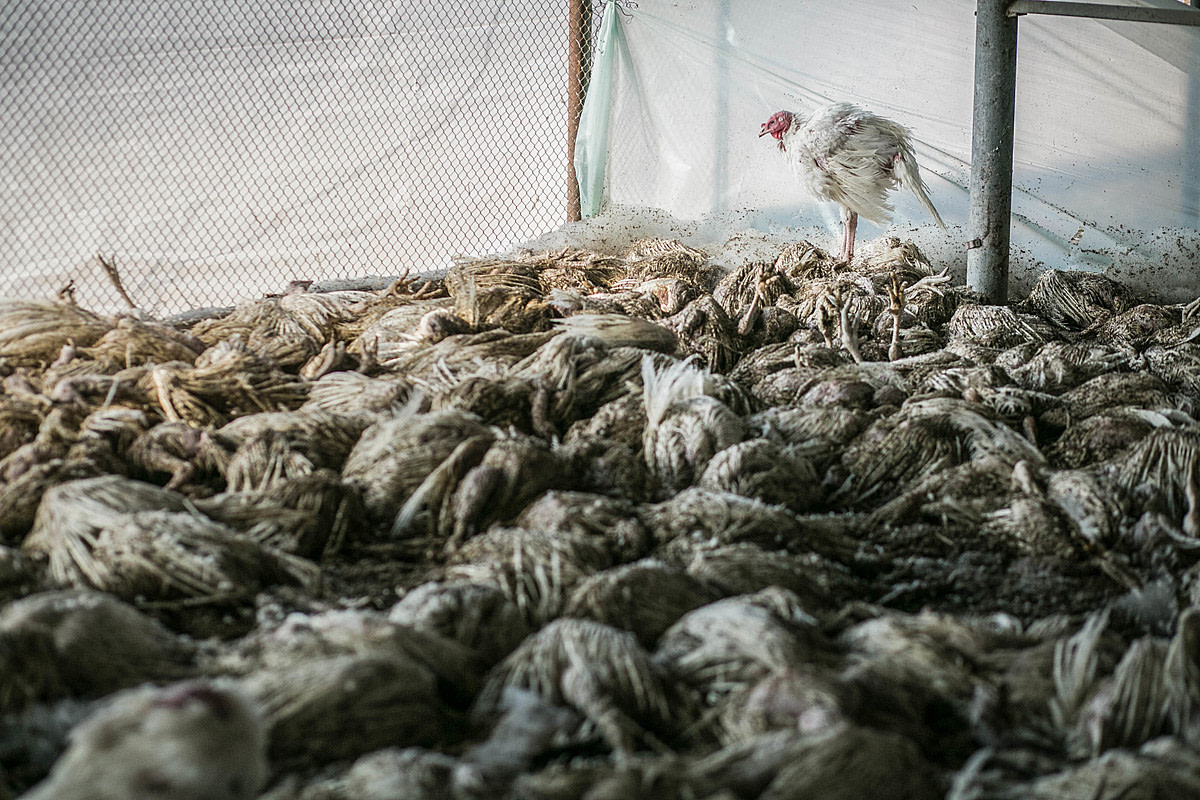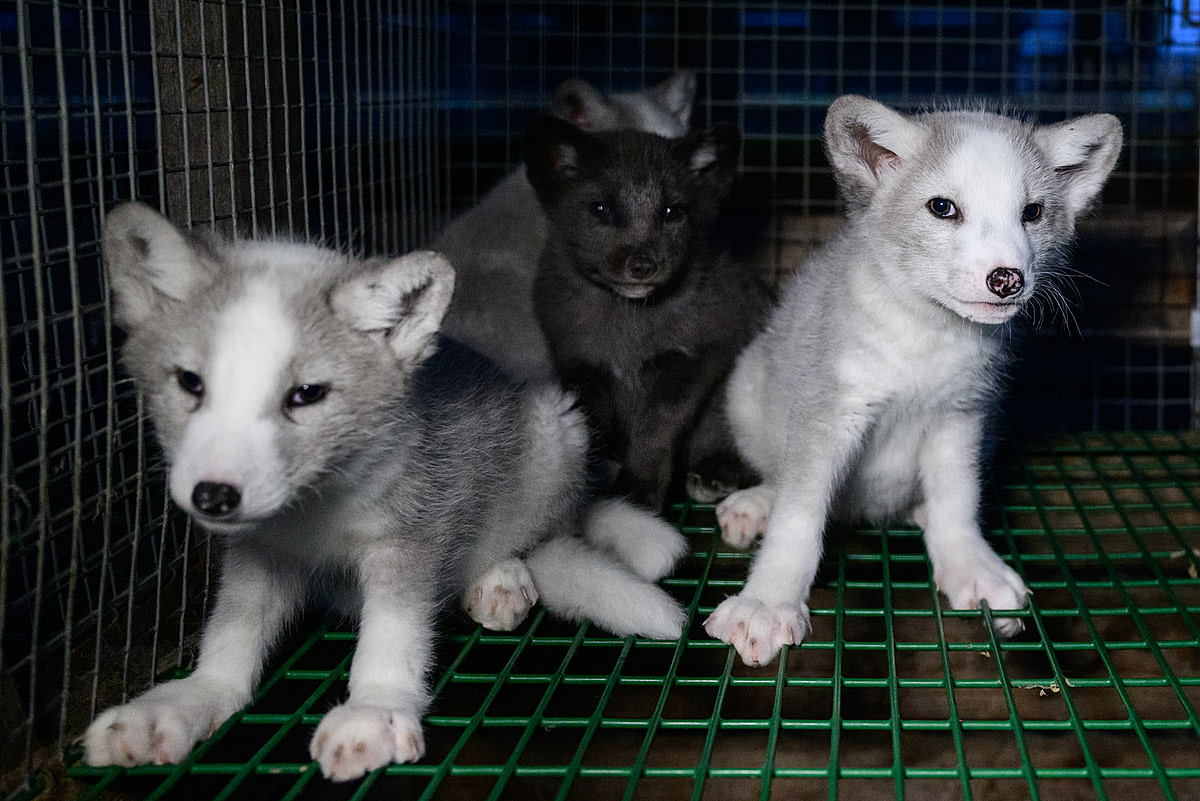A turkey who escaped being smothered by firefighting foam sits on top of the bodies of dead birds from their flock. Following the detection of avian influenza in the turkey flock at this Israeli kibbutz, authorities used compressed firefighting foam to mass-suffocate the birds, claiming it to be the most efficient and humane method of extermination. Numerous birds remained alive or died slowly after the foam’s application. Israel, 2016.
Glass Walls / We Animals
This week, Compassion in World Farming released a detailed report on the spread of bird flu around the globe and the role that industrial animal farming plays. With compelling visuals and insights from We Animals photojournalists throughout, this report takes a deep dive into the hard-hitting facts of our food systems contribution to zoonotic disease risk and spread. CIWF is calling on governments and leading public health bodies to get strategic and introduce major reforms to help tackle bird flu.
“Contrary to popular belief, wild birds are typically victims of the disease rather than the cause… Following 20 years of evolution in farmed poultry, the latest, and most deadly, strain of the virus has adapted to wild birds, meaning that it is circulating independently in wild populations… wild birds are caught up in a cyclical situation where the disease, fuelled by the factory farming system, is spiralling out of control.” — Compassion In World Farming
The report, Bird Flu: Only Major Reforms Can End It, examines the history of Avian Influenza and warns that we could be facing our next pandemic if urgent measures are not taken to transform our food system. Looking beyond the standard biosecurity measures, CIWF goes on to offer a three-point action plan to approach tackling the spread of bird flu, calling for mass vaccination of farmed flocks and major overhauls in both poultry and pig farming industries.
The discarded carcasses of dead Pekin ducks lie in a dumpster a few hundred meters from a Brome Lake Ducks facility in Racine, Quebec. Most of the ducks have been cut open, and it appears as though the upper coelomic cavity was being targeted, possibly to collect samples from the heart, lungs, or trachea. Canada, 2022.
Victoria de Martigny / We Animals
On a Czech industrial egg farm during an avian influenza outbreak, multitudes of dead hens fall from a conveyor into a transport container after being killed in a mass culling operation. Czechia, 2023.
Lukas Vincour / Zvirata Nejime / We Animals
“Bird flu is like a ticking time bomb. Unless we wake up and take urgent action to end factory farming, we will simply be unable to stop its rapid spread across the globe or reduce the risk of a serious human pandemic developing. Cramming animals together in factory farms is not only totally inhumane, it’s creating the perfect place for bird flu and other viruses to spread and mutate into more dangerous strains.” — Peter Stevenson, CIWF’s Chief Policy Adviser and author of the report
Our photojournalists have been documenting the underreported part of the story about bird flu over the past two years, highlighting the unavoidable connection between intensive animal farming and disease transmission. Our photojournalists have documented the effects of the highly pathogenic virus on farmed birds in Canada, US and Europe. Additionally, we have gained access to rare videos of ventilation shutdown and drone footage of mass culls on farms in the US and Czechia; and have poignant visuals showing the culling of birds with compressed firefighting foam inside an Israeli kibbutz. These visuals offer a glimpse into the lives of the animals who are treated as nothing but collateral damage inside infected farms.
A weak and wet turkey poult stands closed-eyed amid thick firefighting foam that also covers their dead flockmates. Following the detection of avian influenza in the turkey flock at this Israeli kibbutz, authorities used compressed firefighting foam to mass-suffocate the birds, claiming it to be the most efficient and humane method of extermination. Visible were numerous birds slowly dying or conscious after the foam’s application. Israel, 2016.
Glass Walls / We Animals
Two hens who survived the ventilation shut-down huddle together in a small battery cage at a factory farm in Iowa. They are lethargic and missing most of their feathers. USA, 2022.
Direct Action Everywhere / We Animals
Thousands of dead chickens are removed from a shed by conveyor belt and loaded into a truck at a factory farm in Iowa. USA, 2022.
Direct Action Everywhere / We Animals
“I thought those chickens had suffered a double injustice. Firstly, they contracted the virus because they were locked up in an intensive farm. And secondly, they were killed in an atrocious way and crushed one on top of the other after a long agony.” — Francesco Ceccarelli, animal photojournalist
During a mass cull of over 264,000 chickens on an Italian chicken farm affected by avian influenza, a loader dumps a bucketful of live chickens into a large bin to be killed by gassing. The birds flap and struggle as they are piled atop one another, and workers pick up stray individuals from the ground and roughly throw them into the bin. It takes approximately 30 minutes to fill the bin with live chickens before it is closed and the gas is administered. During this time, the weight of the birds piled on top of them slowly crushes the live birds dropped into the bottom of the bin. Workers stand on a truck with gas cylinders parked beside a closed gassing bin. Italy, 2022.
Essere Animali / We Animals
A turkey who escaped being smothered by firefighting foam sits on top of the bodies of dead birds from their flock. Following the detection of avian influenza in the turkey flock at this Israeli kibbutz, authorities used compressed firefighting foam to mass-suffocate the birds, claiming it to be the most efficient and humane method of extermination. Numerous birds remained alive or died slowly after the foam’s application. Israel, 2016.
Glass Walls / We Animals
“Watching them load the dead birds into the waste trucks I saw clouds of feathers drifting off in the wind and bird after bird falling onto the ground. Eventually one worker kicked the fallen dead birds into a tractor bucket. This was no way to prevent a highly infectious disease from spreading.” — Ed Shephard, animal photojournalist
A tractor dumps a load of dead turkeys into a truck during a disposal operation at a farm with an avian influenza (H5N1) outbreak. UK, 2022.
Ed Shephard / Generation Vegan / We Animals
Just recently in Finland, where H5N1 has been spreading rapidly, the non-profit organization Oikeutta elaimille documented culls on infected fox and mink farms. The latest cull resulted in the death of approximately 50,000 animals. While the photojournalists followed strict biosecurity measures such as wearing single-use protective clothing and masks to prevent the spread of H5N1, the farm workers were not so diligent, wearing masks on their chin while feeding animals and having open protective clothing and no masks when working in close proximity to cages.
”As long as people support this cruel business, these tragedies will happen more and more.” —Lukas Vincour, animal photojournalist
An ailing young mink on a fur farm sits beside a pile of mink feces at the back of a filthy cage. This mink’s foot was badly injured from being stuck inside the cage’s wire mesh floor. Though the photojournalist was able to help the young animal to free their foot, the mink’s health appeared severely compromised. Laitila, Finland, 2023.
Oikeutta elaimille / We Animals
Last month, Harvard Law School and New York University released a comprehensive report unveiling the extent of zoonotic disease threats in the US, emphasizing that the state and scale of animal industries means it is particularly susceptible to outbreaks of zoonotic disease. Again, pointing towards the issues of intensification as highlighted in CIWF’s latest report.
CIWF is now in communications with UK, US and various European governments urging them to work with the World Organisation for Animal Health and the UN Food and Agriculture Organization to implement the crucial measures laid out in their report.
“Without a comprehensive action plan to fully tackle the key root causes of the disease, the world could face repeated, devastating outbreaks of bird flu for years to come.” — Compassion In World Farming
Read more about this new report via Compassion In World Farming and show your support today by signing their petition.
Data sources: Compassion in World Farming / The Guardian / Reuters
Explore more bird flu visuals.









